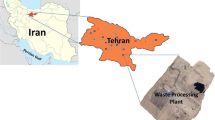Abstract
According to Council Directive 90/679/EEC on the protection of workers from risks related to exposure to biological agents at work, nature, degree and duration of workers’ exposure to microorganisms must be determined. This directive has already been implemented in waste and wastewater management. The present case study investigates concentration and composition of microorganisms in a poultry slaughterhouse in the State of Styria, Austria. From June to November 2002, measurements were conducted at the sampling sites ‘moving rail’ and ‘gall bladder separation’ using the Andersen six stage viable cascade impactor and the SKC BioSampler. The results of this study were compared with other previous studies which were carried out using the same device (ACFM) and the same measurement methods. At the processing area of the ‘moving rail’, the median concentration of airborne mesophilic bacteria was 1.7×106 CFU/m3 which is 8000 times higher than the background concentration of residential areas (approx. 210 CFU/m3). The airborne microorganisms concentration was 1.7×104 CFU/m3 at composting plants which is 100 times lower than at a workplace of a poultry slaughterhouse. The study shows that poultry slaughterhouse employees are exposed to high concentrations of airborne microorganisms throughout the entire work time without using a respiratory protective device. For the protection of employees against airborne biological agents, relevant measures should be introduced to this field of work.
Similar content being viewed by others
References
Andersen A.A. (1958). New sampler for the collection, sizing and enumeration of viable airborne particles. J. Bacteriol. 76:471–484
Barnett H.L., Hunter B.B. (1987). Illustrated genera of imperfect fungi. Fourth edition. Macmillan Publishing Company New York, Collier Macmillan Publishers London
Berghold Ch. and Kornschober Ch.: 2004, Nationale Referenzzentrale für Salmonellen, Jahresbericht 2003. Mitteilungen der Sanitätsverwaltung, 4/2004, 8–13
Council Directive: Richtlinie zum Schutz der Arbeitnehmer gegen Gefährdung durch biologische Arbeitsstoffe bei der Arbeit. Richtlinie 90/679/EWG
De Hoog G.S. and Guarro J.: 1995, Atlas of Clinical Fungi. Centraalbureau voor Schimmelcultures Baarn, Delft and Universitat Rovira i Virgili Reus; Spain
Directive on biological agents: Verordnung biologische Arbeitsstoffe (VbA) BGBL II Nr. 237/1998
Domsch K.H., Gams W. and Anderson T.H.: 1993, Compendium of Soil Fungi. Vol. I und Vol. II, IHW-Verlag Reprint
Hagmar L., Schütz A., Hallberg T., Sjöholm A. (1990). Health effects of exposure to endotoxins and organic dust in poultry slaughterhouse workers. Int. Arch. Occup. Environ. Health. 62:159–164
Hagmar L., Schütz A., Hallberg T., Sjöholm A. (1990). Over-shift decrease in lung function in poultry slaughterhouse workers. American Journal of Industrial Medicine 17: 77–78
Hartung J. (1998). Art und Umfang der von Nutztierställen ausgehenden Luftverunreinigungen. Dtsch. Tierärztl. Wschr. 105:213–216
Hwang M.N., Ederer G.M.:(1975). Rapid hippurate hydrolysis method for presumptive identification of group B streptococci J. Clin. Microbiol. 1:114–115
Hygiene Regulation: Geflügelhygieneverordnung 2000 (GHV) BGBL. Nr. 243/2000 Teil II i.d.g.F
Keener K.M., Bashor M.P., Curtis P.A., Sheldon B.W. and Kathariou S.: 2004, Comprehensive Review of Campylobacter and Poultry Processing. Comprehensive Reviews in Food Science and Food Safety, Vol. 3, pp. 105–113
Kempf A.: 1995, Untersuchungen über thermophile Actinomyceten: Taxonomie, Ökologie und Abbau von Biopolymeren. Dissertation, Fachbereich Biologie der Technischen Hochschule Darmstadt
Konkel M.E., Gray S.A., Kim B.J., Gravis S.G., Yoon J. (1999). Identification of the Enteropathogens Campylobacter jejuni and Campylobacter coli based on the cadF Virulence Gene and its Product. Journal of Clinical Microbiology. 37(3): 510–517
Kotula A.W., Kinner J.A. (1964). Airborne microorganisms in broiler processing plants. Applied Microbiology. 12:179–184
Lenhart S.W., Olenchock S.A., Cole E.C. (1982). Viable Sampling for airborne bacteria in a poultry processing plant. Journal of Toxicology and Environmental Health. 10:613–619
Lutgring K.R., Linton R.H., Zimmerman N.J., Peugh M., Heber A.J. (1997). Distribution and quantification of bioaerosols in poultry slaughtering plants. Journal of Food Protection. 60(7):804–810
Nielsen B. (1995). Exposure to air contaminants in chicken catching. Am. Ind. Hyg. Assoc. Journal. 56:804–808
Oosterom J., Nottermans S., Karman H., Engels G.B. (1983). Origin and prevalence of Campylobacter jejuni in poultry processing. J. Food Protection. 46:339–344
Perfetti L., Cartier A., Malo J.L. (1997). Occupational asthma in poultry-slaughterhouse workers. Allergy. 52:594–595
Pless P., Ursinitsch B. and Köfer J.: 2002, Prävalenz und Resistenzverhalten von Campylobacter spp. in steirischen Nutztierbeständen. Tagungsband der ÖGHMP. 7–10 Mai 2002, Meran
Rahkio T.M., Korkeala H.J. (1997). Airborne Bacteria and Carcass Contamination in Slaughterhouses. Journal of Food Protection. 60(1): 38–42
Reinthaler F.F., Haas D.U., Feierl G., Schlacher R., Pichler-Semmelrock F.P., Köck M., Wüst G., Feenstra O., Marth E. (1999). Comparative investigations of airborne culturable microorganisms in selected waste treatment facilities and in neighbouring areas. Zbl. Hyg. Umweltmed. 202: 1–17
Samson R.A., Hoekstra E.S., Frisvad J.C., Filtenborg O. (1996). Introduction to food-borne fungi. Fifth edition. Centraalbureau voor Schimmelcultures Baarn Delft. Printed by Ponsen & Looyen, Wageningen The Netherlands
VITEK-Automicrobic System AMS, bioMerieux VITEK, Inc. Manual 510558-4 (REV 0686) (1986)
Whyte P., Collins J.D., McGill K., Monahan C., O’Mahony H. (2001). Distribution and prevalence of airborne microorganisms in three commercial poultry processing plants. Journal of Food Protection. 64: 388–391
Wüst G., Reinthaler F.F., Haas D.U. and Marth E.: 1999, Vergleichende Untersuchungen luftgetragener, kultivierbarer Mikroorganismen an ausgewählten Standorten in der Abfallwirtschaft, der Nutztierhaltung und im Anwohnerbereich. In: Schriftenreihe des Vereins für Wasser-, Boden- und Lufthygiene: Stand von Wissenschaft, Forschung und Technik zu siedlungshygienischen Aspekten der Abfallentsorgung und -verwertung, Hrsg.: Th. Eikmann und R. Hofmann, Tagung 30. August bis 1. September 1999. Langen, Band 30, 703–711
Author information
Authors and Affiliations
Corresponding author
Rights and permissions
About this article
Cite this article
Haas, D., Posch, J., Schmidt, S. et al. A case study of airborne culturable microorganisms in a poultry slaughterhouse in Styria, Austria. Aerobiologia 21, 193–201 (2005). https://doi.org/10.1007/s10453-005-9003-x
Received:
Accepted:
Published:
Issue Date:
DOI: https://doi.org/10.1007/s10453-005-9003-x




